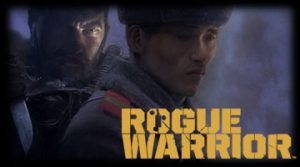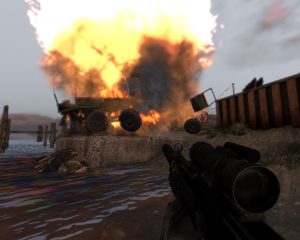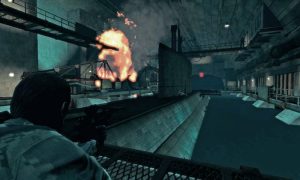Shrapnel: Urban Warfare 2025, formerly known as M.O.U.T. 2025, is a cancelled futuristic squad-based First-Person Shooter developed around 1999 to 2001 by Zombie Studios and published by Ripcord Games, for the PC and the Dreamcast. As the title suggest, it was set in 2025 where player took the role of a member of the Military Operations on Urban Terrain, a special military team whose missions are related to counter-terrorism.
The game was first revealed in November 1999 by IGN, which, at that time, indicated that it was similar to Tribes:
We also learned last night at a Ripcord sponsored press event that Ripcord will be working closely with Zombie on future games based on the Spec Ops concept. Lou Viveros, President of Ripcord, told us about at least two Spec Ops-based projects in the works. (…) Shrapnel, will be a futuristic squad-based shooter similar to Tribes.
More was shared in April 2000:
In Ripcord and Zombie’s Shrapnel: Urban Warfare 2025, you become a member of the elite M.O.U.T. Force, the swiftest and surest weapon in our nation’s growing arsenal against the terrorist threat. The title, which in some ways looks to resemble Red Storm‘s Rainbow Six is a first person shooter in which you carry out various missions against our largest foes.
As the 2025 of the title would suggest, Shrapnel takes place in the near future, although the developers seem keen on stressing the near part. What the game gets from this setting is a slightly sci-fi atmosphere, but the real area of interest is in weapons technology. Placing the game just a bit ahead of the times allows for players to be on the receiving end of a realistic arsenal of advanced weaponry. We’re talking stuff that hasn’t even seen the light of day outside of some loon’s weapon-testing ground, including some items that are best classified as “deceptively deadly.”
In speaking with the game’s producer, we learned of a few examples. Imagine if you will, a grenade, only smarter. These grenades can be programmed to travel a certain distance then spontaneously explode, without even striking the ground. So, say a young man named Mike is actively campaigning for an upcoming presidential election, and while touring through New York City, he smells something fishy in the air. He scans his surroundings inently, and spotting what he believes to be a grenade launcher, he leaps behind a car in order to take cover. But you, the gunman, came prepared with your smart grenades. You get a readout on the distance from the gun to the car – about 50 feet, program the following grenade to explode after sixty feet of travel, aim the grenade at the window, and let her rip. The grenade launches towards the car, breaks through both windows, and explodes in mid air right behind Mike (don’t worry – he was into some bad, bad things). The initial blast may not fully get him in full impact, but the shrapnel does the job.
You’re going to need them as you take to your various missions, all of which are set in realistic cities and feature realistic terrorist threats. The game’s design and AI are being handled by real life counter terrorism experts, the very same guys you design the anti-terrorism training grounds used to prep America’s finest, so we can probably expect a realistic, and therefore tough experience. Thankfully, in addition to the above mentioned futuristic weapons, the video we’ve included below of the game points to the inclusion of laser sighting and sniper modes available on call, and we’ve also learned that you’ll have equipment that can triangulate the location of you and your buddies based on sound.
Fighting terrorism is a team effort, you won’t be alone in Shrapnel. We don’t have much in the way of detail on the game’s team aspect, with Ripcord having only told that we can expect the game’s included online mode to allow for up to eight players simultaneous. That’s all we know at the moment, other than the game’s making use of the Lith-Tech FPS engine.
Further details could be read on Gamespot in December 2000:
Just as in Ripcord’s other Spec Ops games, MOUT’s focus is on realism. The game is uncompromisingly realistic when it comes to inflicting and taking damage. Enemies can be felled with one bullet to the head, and team members are just as easily killed. The game will make you exercise your whole team and take full advantage of your MOUT tactics.
The game will feature many futuristic weapons that, while based on current military prototypes and designs, are completely fictional. Still, the technology in the game sounds very cool. Each member of your team will be wearing a combat helmet fitted with a special HUD capable of triangulating enemy positions based on data from other team members’ helmets. A well-placed team member can alert you to activity behind walls and can even help spot immediate threats. Additionally, the game will feature upgradeable weapons, such as grenade launchers that can be refitted with prototype grenade rounds.
One of the more interesting aspects of MOUT 2025 is its online capabilities. In conjunction with Ripcord’s pledge to make games that take advantage of Sega’s gaming network, MOUT 2025 will be Internet multiplayer compatible, featuring up to eight-player cooperative and deathmatch play.
MOUT 2025 is scheduled for an October release.
Still on Gamespot, the following month, we could read this:
The game essentially has two modes of play: a single-player, mission-based mode and an online, “every man for himself” battle for up to eight players.
A very small section of one of the game’s levels, in a nighttime setting, was playable at the E3 show. This urban area was cluttered with trash cans, elevators, and alleys. In terms of weapons, there wasn’t much variety. Perhaps because the game was presented in a limited setting, the only weapons that were readily available were a straight machine gun and a short-range rocket launcher. Also, the only real power-up was an ammo recharge. According to a Ripcord representative, however, several new weapons and power-ups will be added to the finished product.
Sadly, in March 2001, Ripcord took the decision to cancel some Dreamcast titles, following the restructuration of SEGA after the console didn’t do well in terms of selling units:
Lately, it’s been more of the ugly news of third parties canceling their Dreamcast games and now, Ripcord Games might join that list soon.
“We have put a hold on the further development of our Dreamcast games,” stated John Peterson, Executive Vice President of Ripcord Games. “While we believe the Dreamcast is a great system, SEGA’s new business direction [into the software business] has made us re-evaluate our current state.” Mr. Peterson wouldn’t go so far as to state the Ripcord Games for the Dreamcast – Legend of the Blade Masters, Gorka Morka, and Shrapnel: Urban Warfare 2025 – were cancelled, but are pending publisher’s decision.
Ripcord Games definitely closed offices in April 2001, ruining the chances of Legend of the Blade Masters, Shrapnel: Urban Warfare 2025 and Gorkamorka being released, at least, on PC.
Article by Daniel Nicaise
Images:
Videos:




